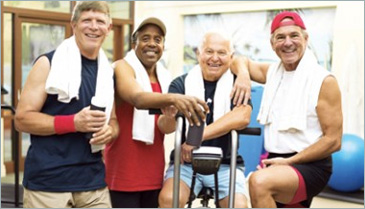 By Gina DeMillo Wagner
By Gina DeMillo Wagner
Experience Life Magazine
If there were a way to double your chances for fitness success, would you be interested? How about a technique to make exercise more fun? A proven way to help you out of a rut or through a plateau?
It may all sound too good to be true, but countless fitness seekers have found that the right workout buddy can do all that and more.
“In my 10 years of experience evaluating what creates long-term health-and-fitness success, the single most important factor is having a support system,” says Wayne Andersen, MD, cofounder and medical director of Take Shape for Life, a nationwide health and lifestyle coaching program based in Owings Mills, MD.
Exercise partners provide a powerful combination of support, accountability, motivation and, in some cases, healthy competition. “They can play the role of teammate, co-coach and cheerleader — all while working out,” says Michelle P. Maidenberg, PhD, MPH, clinical director of Westchester Group Works in Harrison, N.Y.
Maidenberg, who consults on wellness-coaching strategies, says finding the right workout partner (someone you care about and click with) dramatically increases your chances of success. “A buddy can motivate you to do one more set, continue when you feel like you have just had enough and want to give up, or when you are feeling hopeless.”
Ready to partner up?
Great! Keep in mind that not all workout buddies are created equal.
“If you choose someone who does not share a similar commitment to fitness, that can be a distraction or even a deterrent,” Andersen says. “And if your partner is at a radically different level of health, fitness or ability, you could be held back, pushed too hard or even injured.”
Another key factor: Emotional connection. Your workout pal doesn’t have to be your best friend, but he or she has to be someone you like and whom you wouldn’t want to disappoint, Maidenberg says. “Psychologically, if you feel like you have a responsibility and commitment toward another person, you are more likely to follow through on that commitment.”
The most successful fitness partnerships fall into one of three categories: the pal-based buddy system, the small group and the coupled pair. Take a look at them all, then consider which collaborative arrangement (or arrangements) might work best for you.
The Buddy System
A dynamic duo, typically friends or colleagues, who train together one-on-one or have developed a regular routine of connecting for fitness activities.
Best for:?Those who shy away from gyms and fitness classes when solo, or who tend to be more introverted. Great for those focused on specific, shared or complementary goals (e.g., losing weight, getting stronger, training for an event). Ideal for pals who want to spend more time together and be more active. Also great for coworkers or stay-at-home parents.
Why it works:?“Having a reliable workout buddy increases your chances of sticking with your program,” says Elizabeth Lombardo, PhD, MS, PT, psychologist, and physical therapist. It can be hard to push yourself during solo workouts, she notes, and it’s dangerous to lift heavy weights without a spotter. A workout buddy can provide some healthy competition while keeping you within safe limits.
The Group Effort
A small group of people whose membership may vary by the day, but who generally work out at the same pre-appointed time and place — as a group, with a trainer, or simply in the same vicinity as one another.
Best for:?People who like to combine social time with exercise; coworkers, students or parents whose schedules align; cyclists, walkers and runners, or any group of fitness-minded friends. Also great for people who like the interaction of a group but may not want to participate solo in a bigger group fitness class.
Why it works:?Whether you’re jogging shoulder-to-shoulder with buddies or simply glancing across the fitness floor at familiar faces, there’s a strong motivation in the feeling that “we’re all in this together,” Maidenberg says. “A group normalizes the need to maintain effective health-and-fitness behavior and promotes a feeling of community.”
The Couple Collaborative
A couple who pursue their fitness activities together. They may or may not do the same workout, but they block off time and space for being active as a couple.
Best for:?Couples who support each others’ goals; couples who need more quality time together and have trouble fitting it in their schedules; parents who can take advantage of childcare at the gym; anyone looking for a fun, active date.
Why it works:?You’re most successful at reaching your goals when the people closest to you are on board — or, better yet, an integral part of the team. Scheduling is often easier with a partner, since you can carpool to the gym. All those endorphins and pheromones work to increase your attraction, too. “When you’re empathetic and praise your partner during a workout, it spills over into your relationship,” says Lombardo. You learn you can tackle anything as a team, and that makes for a stronger relationship.
Keep in mind, whether you’re currently working out with your spouse, a buddy or a group of fitness pals, there’s no need to limit yourself to just one fitness partnership. You can hit the gym with your sweetie a couple of evenings a week, walk with a colleague over the lunch hour and ride trails with your cycle club on the weekends. The more people you have actively engaged in supporting your fitness efforts, Andersen says, the more likely you all are to enjoy the process, and the results.
ABOUT EXPERIENCE LIFE
Experience Life is an award-winning, whole-life health and fitness magazine that aims to empower people to live their best, most authentic lives, and challenges the conventions of hype, gimmicks, and superficiality in favor of a discerning, whole-person perspective. Visit ExperienceLife.com to learn more.




